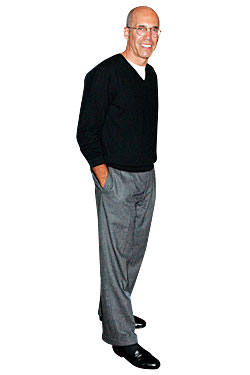
J effrey Katzenberg had taken the red-eye and hadn’t eaten lunch, so he’s hungry. Still, he’s jovial and Hollywood touchy, powering up on canapés in a small private room on the second floor of the ‘21’ Club. Next door, his company, DreamWorks Animation, is throwing a party ostensibly to celebrate the DVD release of the hit How to Train Your Dragon. But really it’s the beginning of Oscars glad-handing season, and Katzenberg has to be carbed up with tiny pieces of bread to do his job.
It is his second big engagement in a very long day. (He’s planning to fly back as soon as the Dragon thing is over.) In the morning he spoke at a 3-D convention at the Waldorf-Astoria. (“I don’t know what that was,” he admits about the event, which gathered together everyone from gamers to exhibitors to equipment manufacturers.) That’s what Katzenberg is most dedicated to right now: 3-D. The mogul, who revived the animation tradition at Disney to great profit, has declared that all of DreamWorks’ new animated films will take advantage of that technology.
Since Katzenberg’s clearly not looking forward to joining the crush of humanity across the hall, I get as an immersive case for 3-D’s coming domination of all media as I ever might want. “The aha! moment, if you will, happened in 2004,” he explains. The movie that changed him was The Polar Express, Robert Zemeckis’s creepy dip into an uncanny valley. Katzenberg didn’t like its “photo-realist” virtual actors, but the 3-D was a revelation: “I was so blown away and simply exhilarated by the experience, the sense of being immersed into the story. I came out of that theater 100 percent convinced that he was showing me the future.” He hurried back to the company’s tech staff and ordered them to “figure it out.” (Interestingly, this epiphany happened not long after DreamWorks Animation was spun off into a separate company from the ailing DreamWorks.) He now believes, to the point of evangelism, that 3-D is coming to every device with a screen, including phones. When I meekly mention that I’m not sure I want to look at a phone through glasses, Katzenberg gets starkly assertive. “You’re showing your age! You’re old! You’re ancient!” he says, without malice but not in jest either. “In a cataclysmically changing world we live in, if you want to survive, you have to change. You can’t not change. You have to have that device,” he says, jabbing at the iPhone recording us. “These devices are powering you.”
DreamWorks Animation has two films, Dragon and Shrek Forever After, among the year’s top-ten grossers, and a promising third in the wings (Megamind), so Katzenberg is feeling optimistic. Dragon is his company’s internal pick for the animated-feature nomination for an Oscar, and so the party is crawling with invitees from the Academy, the New York Film Critics Circle, and the National Board of Review. “He better talk to everyone here,” mutters a DreamWorks PR guy, scanning the crowd.
It is now time to go in and charm the voters; Katzenberg’s various handlers are poking their heads in the door. He sends a couple of e-mails, eats another hors d’oeuvre. “Okay,” he finally says. “Shall we dive in over there?”
The crowd filling the room is on the older side. To be honest, it looks exactly like the ‘21’ Club on any other night. “This might be a good time to meet Katzenberg,” says a loud man in a louder tie to his ravishing young companion, grabbing her by the arm. Indeed. For an hour and a half, Katzenberg remains in maximum mingling mode, laughing it up with everyone from affable-looking Gerard Butler to Butler’s hardass-looking agent. He chats with septua- and octogenarian legends—The Jerk and Lenny producer David Picker, Serpico and Scarface producer Marty Bregman. He talks to a bald bespectacled man who looks exactly like him but is about seven feet tall. The only young people there are the How to Train Your Dragon filmmakers. He estimates he’s talked to 150 people tonight, most of whom he’s never met before.
Recently, Katzenberg said that DreamWorks Animation’s mission statement is a direct inversion of Walt Disney’s: movies “for adults and the adult that exists in every child.” Dragon, he points out, is the first animated DreamWorks feature with an adolescent protagonist. “Disney’s movies were a young boy becoming a man or a young girl becoming … well, a princess, usually,” he elaborates. “John Lasseter”—the Pixar chief and director—“is the embodiment of Walt Disney today. He’s making movies from that point of view and doing it beautifully, perhaps even better than Walt Disney himself. But kids today are more adult than ever before. The degree to which they lose their innocence is something unlike when you and I were kids.” So you’re not into childlike wonder, then? “Nah.”
Have good intel? Send tips to [email protected].